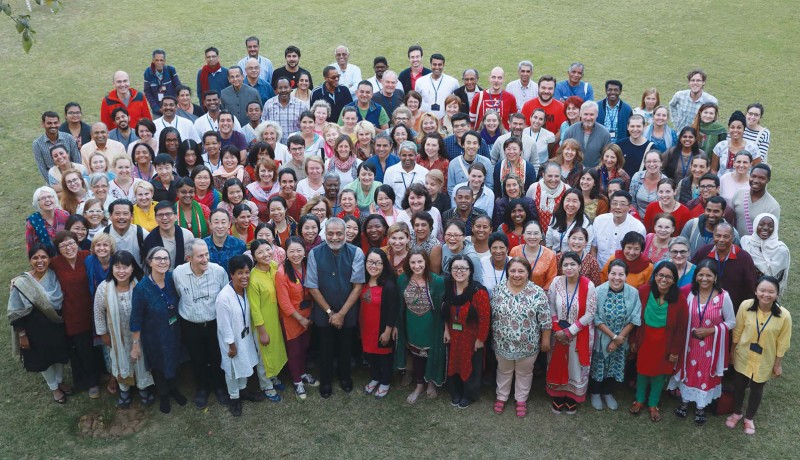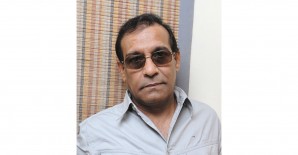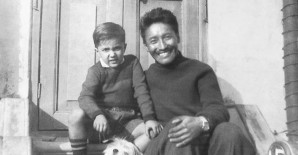
Columns

‘Without individual peace, there can be no world peace’
“You are the experiment, you are the experimenter, and you are the outcome,” says Kamlesh D Patel, the fourth spiritual Guide in the Sahaj Marg system of Raja Yoga meditation, popularly known as Heartfulness (www.heartfulness.org). Affectionately referred to as Daaji, he is equally at ease meditating in the sublime stillness of a Himalayan ashram and addressing seekers at bustling meets in London, Paris, Sydney and New York. Indeed, Daaji displays the perfect blend of the eastern heart and western mind.
Born in 1956, Daaji spent his childhood in a small village in Gujarat. After graduating with a degree in pharmacy, he did his postgraduate studies in the US, where he went on to own and manage 12 pharmacies. As president of Shri Ram Chandra Mission currently, he keeps travelling, overseeing meditation centres and ashrams in over 120 countries and conducting meditation with yogic transmission worldwide. Daaji and his wife have two sons. “By tuning into our heart, we learn to be centred in our highest self,” he observes in an email interview with Srirekha Pillai.
EXCERPTS
Can you elaborate on your personal tryst with spirituality?
I was drawn towards spiritual matters from a very young age and continue to be a student of spirituality. In my teens, when I started meditating, my mother would say, “It’s not that you started now; you started when you started walking. When your father would go to the temple, you would pull his dhoti, making sure he took you with him.”
At a young age I wanted to become a sannyasi; one day, I left home and went to a riverbank where a group of sadhus lived. The eldest among them asked me why I was there. When I told him, he advised me to go home and discover spirituality in worldly life. Later, in 1976, when I was19 and studying pharmacy, one of my friends took me to a Heartfulness trainer, a very simple lady in her 40s, who gave me an initiation into the Heartfulness system. Soon after that I met my first Guide, Babuji. I had an inquisitive mind, so I backed the teachings of my Guide with my own experiences in meditation.
Whenever we sit in meditation with an open heart, we receive a particular experience. We start with the suggestion, the hypothesis, that there is a source of light present within our hearts and it is drawing us inwards. Like scientists, we observe and experience each time we close our eyes and connect within. I would say everyone’s tryst with spirituality is personal, based on experiences along the path. Trust your instincts, your feelings, and follow your heart.
What exactly is Heartfulness meditation? What sets it apart?
The attributes that define Heartfulness meditation are as follows:
- Meditation is done on the presence of Divinity within the heart.
- This meditation is aided and supported by pranahuti or Yogic Transmission.
- Heartfulness has a process of yogic cleaning to fine-tune and purify the mind.
- Another important element of Heartfulness is the practice of connecting with your higher self through prayer.
Heartfulness is a spiritual path that leads us to higher levels of consciousness. As a result, we realise our human potential. Each day brings us newer levels of awareness and consciousness. By interacting daily with new doses of higher levels of consciousness, our journey into the vast arena of consciousness begins with the simple act of meditation. The beauty is that today’s higher level of consciousness then becomes the normal state of awareness, waiting for tomorrow’s dose of higher consciousness, which then becomes normal, and so on. Thus, the journey unfolds.
You talk about Yogic Transmission during meditation. Can you elaborate on that?
What is this pranahuti or Yogic Transmission? To answer briefly, it is spiritual food. Just as we have nutrition for the body, and mental enrichment and education for the mind, Transmission enriches the soul.
When the soul is satisfied with Transmission, you will receive so much grace and peace, often resulting in a deep meditative state. You will only know this from experience, so I encourage everybody to try it out. Conduct an experiment. First, meditate without Transmission with the Heartfulness technique. Then, try meditating again the same way, this time with the help of a trainer. You can find a trainer through heartspots.heartfulness.org, or you can remotely connect with a trainer on the ‘Let’s Meditate’ app. Try this experiment as many times as you like and observe for yourself the difference between meditation with Transmission and without.
What is the role of a modern-day spiritual guru?
In every aspect of our lives, when we are seeking to gain mastery over a subject or skill, we look towards the experiences of those who have gone before us. At school, we seek the guidance of teachers to teach us subjects and expose us to new knowledge. If we want to climb Mount Everest, we seek the guidance of the sherpas who know the path and can lead us to the top. Similarly, in spirituality, the role of a spiritual guru is to act as a guide, serving us and bringing us deeper within ourselves. Today, we find more and more factors pulling us externally, making it important for a spiritual guru to be able to show us the simple way to interiorise. It is important to test a guru, to make sure that he has the capability to take you towards your chosen goal, just as you would if you were looking for a teacher in any other field.
What is the true meaning of life?
The meaning of life changes as we grow. The purpose with which we enjoyed our childhood changes during our high-school days. It further changes when we are hunting for jobs, settling down in family life and, later, with grandchildren. At every phase, the meaning changes. We realise that with ever-changing understanding and purpose, during each phase of life, there is still something more, something greater to fulfil.
The thirst for the inner search cannot be quenched by fulfilment at the external level. It is like offering someone who is hungry just a menu or a beautiful photograph of a sandwich. Will that fulfil their hunger? Would a person searching for God Realisation be happy if someone offers them scriptures or even peace of mind? It is like diverting the attention of a child who is crying by whistling and making funny faces.
Though the destination may not be in sight, having taken the correct path itself will shower you with a lot of peace. Gaining such a state of calmness at the very outset is the sign that you are on the right track.
What ails the world today?
Many of us have lost a sense of peace and simplicity; also, happiness and poise. Instead, we feel burdened by complex lives involving worries, conflicts, fears, anger, guilt and a lack of fulfilment. Greed and avarice are also not progressive traits. Without individual peace, there can be no world peace. More and more contentment will lead to infinite contentment in such a way that the seeds of contentment we have cultivated in our heart may bloom one day and create a forest of contentment.
Today, political and social discourses are getting increasingly defined by anger, hatred and negativity. How do we deal with it?
It is easier to talk about it; action is harder. We can easily say that we should consciously choose not to indulge in negativity and instead cultivate our ability to discern truth from untruth. We all know that negative discourse and hatred are not constructive, as they only breed more negativity and hatred. But how do we change these patterns?
Whatever the issue, the root cause is the individual self. Many individuals coming together, cherishing universal values, creating similar vibratory patterns, giving birth to an egregore of simplicity and purity, will in turn affect universal or cosmic consciousness. Here, Heartfulness offers the solution. Mega change is possible only when individuals change. Through the Heartfulness practice of cleaning, we are able to remove the complexities of negative emotions and thoughts, layer by layer, and feel greater lightness and positivity. The purer the heart, the easier it is to connect within and feel joy, which is the quality of the soul.
Is humanity getting undermined owing to superficial divisiveness and differences such as ethnicity, religion, caste, gender, language, etc.?
Do you need an answer from someone? It is obvious we cannot continue to hold onto differences if we want to create long-lasting harmony. Differences are also productive as long as we make use of the differences in constructive ways. Sometimes agreeing with one another may bring harmony but fail to create a progressive consciousness. But as long as we continue to harbour prejudices and create conflicts because of differences in ethnicity, religion, caste, gender and language, we are losing out on the rich diversity of humanity, and missing the bigger picture.
It is only the ego that says, “My way is the best way,” or “We are better than them,” and that ego can pull us down into a black hole of narrow-mindedness. Open-mindedness results from open-heartedness, which naturally develops the more we meditate on the heart. We become open to other perspectives, and learn how to accept many differences without compromising our own values. It is up to us to ensure that we come together in oneness.
What is the antidote to fanaticism and hatred?
Hatred towards others is always a reflection of self-hatred. So when we purify the heart of all its negativity and allow our consciousness to fill with love, hatred will automatically disappear. When we study the teachings of different religious texts and the ways of life they have advocated, we realise there is an inherent unity among all religions. Actually, how can there be any fundamental difference between one true religion and another, as they are describing the same Principle we call God? The outer differences are merely owing to superficial differences in culture, era, etc. My first Guru, Babuji, used to say vegetarianism would not be a good idea in an Eskimo’s religion, as it would be highly impractical!
When we meditate sincerely, we not only recognise the inherent unity among all religions and faiths but feel that unity. Brahma of the Hindus is the same as Allah of the Muslims, God the Father of the Christians, Ahura Mazda of the Zoroastrians, and so on. There can be no difference among them, as all acknowledge that there is only one God.
What is the key to happiness?
Babuji used to say, “More and more of less and less”. At first this sounded quite confusing. Over time I realised he meant we need more and more of less and less desires. Our happiness can be seen as a quotient: the number of desires fulfilled, divided by the total number of desires. As a result of acquiring greater understanding of life through meditation, we realise that as our number of desires reduces, the quotient becomes higher. As our total number of desires (the denominator) approaches zero, the closer we come to infinite happiness.
How would you define success?
Success is about accomplishing an aim or goal. A pure, regulated mind can be projected successfully in any direction and towards any goal. So, instead of going after success, perhaps we should build the foundation of success by meditating. Then, we are able to manage the demands and needs of the task at hand, so as to succeed at whatever we are yearn for: financial, marital and spiritual success.
What is the ultimate goal of life?
The ultimate goal of life is oneness, to become a truly integrated human being. That is what Yoga means: to unite. Oneness of the higher self with the lower self, the outer personality with the inner being, and oneness with those around us—that should be our goal.
Can we shape our destiny?
It is up to each one of us. Everything we experience is a state of consciousness, and it creates a certain vibration of energy. When we change our inner vibrational state, our inner consciousness, we are able to change the outer manifestation of our lives. There is no predetermined destiny other than that which we have created for ourselves. When we remove the effect of the past from our consciousness and focus on building a better future, we change our destiny. This is what spiritual practice is all about: changing the direction of our destiny from a downward trend—involving more entropy, heaviness and negativity—to an upward trend towards balance, lightness, love, peace, etc.
Is there life after death?
The teachings of all religions have pointed to something beyond death. So does modern research in psychology and science. Everything in nature is based on resonance and vibrational compatibility. So what happens to us at the time of death will very much depend on how we have lived this life, and the inner state we have at the time of death. That is why Babuji advised us to create purity by living a lifestyle of such a high order, so that purity can weave our destiny with the Ultimate.
Having acquired a certain vibratory level in this lifetime, the soul or energy will reach the corresponding vibratory dimension at the moment of death.
Do you believe in the essential unity of all religions and human experiences?
As I mentioned, there are no fundamental differences among religions, as they are describing the same Principle that we call God. All religions advocate love and compassion towards fellow beings and for everything that lives on Mother Earth. It is our understanding that has created differences. When we have a spiritual practice, these things become clearer. Meditation uplifts our understanding, helps us delve deeper, develop tolerance, and love all.
All religions have particular principles, dogmas and beliefs. For example, in Hinduism there is the idea of worshipping a form representing God. The original idea was to transcend that form to formlessness, akaar to niraakar. This should happen naturally, so that instead of seeing God as the form, a seeker feels the presence of God within himself and later on all around. Further, if the seeker is sincere, he can further transcend the experiences and become that particular quality.
Let me give you an example: instead of loving, you yourself become love personified. At the highest pinnacle of evolution, this changes to yet another vibratory level where there are no words that can convey the state. Only analogies can be given and yet they remain an incomplete description of the final state. For example, the description of a drop merging in the ocean that becomes the ocean; there is no individual drop left to describe the ocean.
When we see life from this level, at the end we cannot help but see the unity prevailing in everything.
How can we elevate ourselves spiritually?
It is possible through experience and practice. You can only learn so much about becoming a doctor by reading books and shadowing others. The real understanding is developed through the experience of putting those skills into action. Likewise, while there is much we can learn from scriptures and lectures, to grow spiritually we need to put those teachings into action.
Based on my 40-plus years of experience with Heartfulness, I would say the following:
Can there be joy without peace?
Can there be peace without harmony?
Can there be harmony without contemplation?
Can there be contemplation without thinking?
Can there be focused thinking without meditation?
Spiritual elevation is possible with meditation on the heart.
Can spirituality and materialism coexist?
Why must we differentiate? It will be wonderful if we allow spirituality to infuse itself into material life. Then, even a materialistic approach to life will become spiritual. The beauty is in the integration.
For long, the world has looked to India for spiritual guidance. What’s it about our civilisation that makes us spiritually rich?
We have always prided ourselves on this, but can you say that today we are spiritually rich? That would mean a nation known for its integrity, honesty, inclusiveness and a people whose way of life reflected a high state of communion with God.
I am not saying that India is not spiritually rich, but we cannot rest on the laurels of the past. It is up to Indians to become spiritually uplifted if India is to have such a reputation.
The ancient traditions of India are rich with spirituality, and modern India also has as much to offer the world in spirituality as it has ever had. The question is: what are we doing with it in our own lives?
Is spirituality evolving into an industry now?
Babuji used to say, “God is not for sale.” He would go on, “And if He were for sale, and you could afford to buy Him, why would you need God?” For this reason, he would also say that any serious spiritual system cannot charge for the practice offered. Heartfulness meditation has always been and will always be free of charge. We have no desire to be Yoga merchants.
You talk about the need for a scientific bent of mind. Can science and spirituality converge?
Science and spirituality have never been at odds with one another, although science and religion have sometimes appeared to be so at times in human history. Today, we are beginning to reach a stage in scientific research where we can show evidence corroborating spiritual knowledge.
For example, Swami Vivekananda is supposed to have said, “We are what our thoughts have made us; so take care about what you think. Words are secondary. Thoughts live; they travel far.” Today, we can observe how certain types of thoughts activate certain circuits in the brain. For example, angry thoughts lead to erratic heart-rate variability and are associated with particular circuits in the brain, whereas happy thoughts lead to regular heart-rate variability and will activate the brain differently. Over time, a person’s predominant psychology will cause the brain to be continuously activated in a certain pattern, which reduces neuroplasticity and would mirror that person’s personality.
Similarly, Lord Jesus said that wrath and envy are sins. Today, we know that anger and jealousy are pro-inflammatory emotional states, which can lead to the development of various chronic diseases. Through scientific research, we will continue to see an increasing convergence in traditional spirituality and modern science, and I encourage research efforts in this direction.
What is the role of spirituality in wellness and self-healing?
Material therapies such as exercise and diet are valuable tools for wellness and healing, but self-healing also requires a fundamental shift in consciousness—in our psychological and emotional processes. Our predominant thought patterns, when repeated over many years, solidify into rigid impressions, which we call samskara in the Heartfulness way. When that state of being is one of disease, due to disturbed psychological and emotional states, medical approaches to healing are often insufficient.
For healing to occur, a person needs to remove the psychological patterns causing him or her to remain ill. Purifying spiritual practices like the Heartfulness cleaning can accelerate the process of self-healing by removing the rigid patterns built by samskara. I think spirituality has a complementary role to play in the healing process.
Our human system has a very wonderful characteristic when it comes to observing and looking after our health: when nothing is wrong, we remain carefree and oblivious, but when something is wrong our heart definitely lets us know—as long as we listen to it!
For example, if our breathing is healthy and normal, we are not even aware we are breathing, but if we have a cold or asthma, we will surely be aware of our breathing. The same is true with our mental well-being: when everything is healthy, we are not even aware of our mental processes, and we feel balanced and contented within ourselves. But when things are out of balance, our heart gives us clear warning signals that something is wrong. The practices of Heartfulness teach us to listen to the heart in a very natural way.
We also have this beautiful term in Sanskrit for health, swasthya. It has a profound meaning. It is made up of two Sanskrit root words: swa meaning the self and stha meaning centred. So swasthya can be roughly translated as ‘centred in one’s own self’.
When can we have health? The word itself tells us; only when we are centred in ourselves. How we identify ourselves defines who we are. If we focus too much on the physical or mental body, we will not become integrated holistic beings. When we identify with our true self, this will in turn encourage us to look after our mental and physical development.
How can we create positivity around us?
First create positivity within yourself, then your inner condition will radiate into your surroundings effortlessly, just like the fragrance of a rose.
Why do many turn to spirituality in their silver years?
We often spend much of our younger years chasing external goals like wealth, love, family, status, comfort, etc. Eventually, we realise they are not enough to bring us inner happiness. By the time we are older, we are hopefully also wiser. Perhaps we are able to take the time to reflect, look inwards and say, “Let me give spirituality a try”.
It is not that we then reject wealth, family and human love, but only that we strive for balance. In fact, my experience is that because I meditate, my worldly life also improves. I am better at my business, and I develop the qualities to have healthier relationships, manage stress and conflict, and accept other people and situations just the way they are instead of wanting to change them.
Heartfulness relaxation can be practised from the age of five, and Heartfulness meditation from the age of 15. Postponing spiritual practices for a later age is a suicidal approach. Meditation requires us to sit comfortably for at least half an hour at a stretch. I have seen some seniors unable to sit comfortably because of health issues. The Source is open to all ages, so why not tap into it at an early age instead of waiting until it is not so easy?
What is the mantra for successful ageing?
Have you seen a confused person? He will look tense and restless, his shoulders will droop, and his eyes and eyebrows can at times bring a chill to your heart. Even a young man in this state will look older, whereas a person who has pursued a spiritual path flowers with age. He or she will become more and more beautiful, radiating the fragrance of peace, calmness and stillness around them. If you mean ageing in this way, I highly recommend meditation to everyone, as it clarifies confusion and helps us deal with the conflicts of daily life.
The body is governed by physical laws and has an expiry date. True ageing is much more than that. With meditation on the heart, our ability to make wise choices grows: to distinguish right from wrong and good from bad. We learn to listen to the heart, which leads us in the right direction. We are able to follow its wisdom with courage. Successful ageing is more about developing wisdom and greater expansion of consciousness to become the best we can.
What is your panacea for the ills plaguing the world today?
As I said, world peace starts with individual peace. When we are able to individually bring ourselves into balance, we will create a peaceful, sharing and happy world, where we exist together in harmony. A world, where we share instead of hoard, love instead of hate, and help instead of harm.
Are you hopeful about the future of mankind?
Yes. My second Guide, Chariji, used to say, “My life is my hope and hope is my life”. Hope is the foundation of all change in this world. Without hope, there is no life, no world, and no humanity. They say that when the night is darkest, the dawn is near. I am very hopeful that the future of mankind will see very evolved, loving and kind individuals.
Daaji is offering a series of introductory and advanced online classes on Heartfulness meditation free of cost. Those interested can go to www.heartfulness.org/masterclass to register
Photo courtesy: Shri Ram Chandra Mission Featured in Harmony — Celebrate Age Magazine January 2018
you may also like to read
-
Mental workout
Mukul Sharma tells you how to keep those grey cells ticking Everyone will ultimately lose his or her brain….
-
Helpline
Dr Harshbir Rana answers your queries on personal and social issues related to ageing, elder care and intergenerational relationships ….
-
Off the cuff
Raju Mukherji pays tribute to his first hero, Tenzing Norgay, an exemplary mountaineer Darjeeling, 1955. Dr ‘Pahari’ Guha Mazumdar….
-
Yoga RX
Shameem Akthar shows ways to control debilitating ankle pain through regular practice Ankle pain is so common and prevalent….







